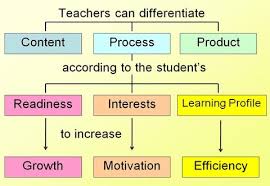
Performance Standard 4: Differentiated Instruction:
The teacher challenges and supports each student’s learning by providing appropriate content and developing skills which address individual learning differences.
|
Performance Indicators at the Level III Level
|
|
4.1 Differentiates the instructional content, process, product, and learning environment to meet individual developmental needs.
4.2 Provides remediation, enrichment, and acceleration to further student understanding of material.
4.3 Uses flexible grouping strategies to encourage appropriate peer interaction and to accommodate learning needs/goals.
4.4 Uses diagnostic, formative, and summative assessment data to inform instructional modifications for individual students.
4.5 Develops critical and creative thinking by providing activities at the appropriate level of challenge for students.
4.6 Demonstrates high learning expectations for all students commensurate with their developmental levels.
|
|
Performance Rubrics
|
|
Level I
|
Level II
|
Level III
|
Level IV
|
|
The teacher candidate does not challenge students by providing appropriate content or by developing skills which address individual learning-differences.
|
The teacher candidate inconsistently challenges students by providing appropriate content or by developing skills which address individual learning differences.
|
The teacher candidate consistently challenges and supports each student’s learning by providing appropriate content and developing skills which address individual learning differences.
|
The teacher candidate continually facilitates each student’s opportunities to learn by engaging him/her in critical and creative thinking and challenging activities tailored to address individual learning needs and interests. (Teacher candidates rated as Exemplary continually seek ways to serve as role models or teacher leaders. This level is not intended for formative assessments of teacher candidates and may only be used in the summative assessment with proper documentation of the teacher candidate’s consistent performance at this level.)
|
|
Examples of Evidence/Artifacts to demonstrate performance on this standard:
|
- Facilitates learning through differentiation of content, process, and/or product.
- Uses assessment data to inform instruction and provide instructional opportunities that vary in degree of difficulty and/or student interest.
- Plan a learner-centered environment that allows for student choice, flexibility, and independence.
- Plan advanced learning for gifted learners.
- Plan remediated learning for struggling students.
- Create and understand students as individuals in terms of ability, achievement, learning styles, and needs.
- Monitor and pace instruction based on the individual needs of students.
- Allow students to work alone or in small groups when appropriate.
|
|
What it is:
|
What it isn't:
|
- Designing instruction that motivates each student and communicating content in such a way that students are able to comprehend based on their individual prior learning and ability.
- Recognizing individual and group differences among students and accommodating those differences in their instruction.
- Reflecting on students as individuals.
- Understanding what students should know, understand, and able to do as the result of a segment of learning.
- Monitoring and assessing student progress, as well as proper management of the classroom.
- Offering personalized scaffolding, often inventing supports on the spot as a student falters.
- Developing a rich mental database of examples, metaphors, and enrichment ideas to draw on.
- Using flexible means or multiple paths to reach defined ends.
- Creating a caring classroom in which student differences in ability, culture, language, or interests were seen as assets, rather than hurdles.
- Meeting the same standards through the same content/process but may demonstrate learning through differentiated products.
- Discovering and examining students their strengths, talents, interests, and resources with teacher guidance.
- Creating successful group learning activities designed to help peers of varied academic strengths and weaknesses work together.
- Developing students who can self-monitor learning goals and demonstrate how they met them.
|
- Uniform strategies for all
- Placing students into groups based on ability without tailoring instruction to the different groups
- No flexible learning grouping
- No pre-assessments
- Not considering student interest, choice, learning style or depth of lessons (for different ability levels)
|
|
Sample Questions for Conferencing:
|
- How have you determined which differentiation strategies are appropriate for your students?
- How have you adapted instruction?
- How have you worked with teachers to develop differentiation strategies for special needs and gifted students?
- How do you use technology and resources to differentiate instruction?
- What is your process for determining how to group students for particular lessons?
- How do you use data to support your grouping practices?
- How do you determine whether or not a group is working well?
- How do you make adjustments to improve effectiveness?
- How do students set their own learning goals in the classroom?
- How do you support student goal-setting and self-assessment during your lesson?
|
Reference and for more information visit
https://www.gadoe.org/School-Improvement/Teacher-and-Leader-Effectiveness/Documents/TKES%20Fact%20%20Sheets%207-11-2012.pdf
